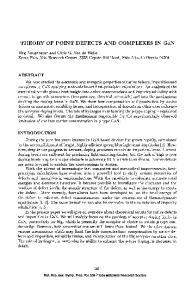Theory of Solid-State Defects
- PDF / 749,712 Bytes
- 5 Pages / 604.8 x 806.4 pts Page_size
- 18 Downloads / 319 Views
se which also identifies discrepancies ("stretched exponential" behavior). Thèse ail show theory used to organize massive amounts of data, to identify what is novel, and point to significant issues. Orders of Magnitude: Defining the Issues When a new material is encountered, which defects are important? Will there be vacancy-interstitial pairs (Schottky defects) or just vacancies of several types (Frenkel defects)? Will ions occur in nonstandard charge states, like 3+ Fe ions in FeO? Will one species move on to the sites of another, e.g., As onto Ga sites in GaAs? Can one dope the material with electrically active impurities? How will properties vary from material to material in some class, like the M-V semiconductors? Even simple answers can be useful answers. At one level, électrons can be treated implicitly only. Born's model of ionic solids as polarizable point ions, interacting through transférable interatomic potentials, was the basis for describing cohésion, dielectric and vibrational properties of perfect solids.5 A major development was the first accurate approach to the energetics of charged defects in ionic solids,6 systematically matching an atomistic central région to a continuum dielectric outer région. This Mott-Littleton strategy gave the first accurate defect formation énergies, and is the basis of state-of-the art codes, like HADES, CASCADE, and ICECAP.7 Self-consistent embedding is now part of many théories of defects in solids. Resolving Complexity Complexity is the norm for advanced materials.8 When a solid-state laser degrades, when mechanical properties change under irradiation, defect processes occur in parallel on timescales from picoseconds upward. In a composite material, defect phenomena may happen in the matrix, the fiber, or the interface. When a métal is oxidized, interfacial, diffusional, and impurity processes co-exist. Separat-
ing thèse processes by experiment alone may not be feasible. The proper use of theory establishes priorities, and even modest estimâtes of well-chosen parameters can suffice to show what need be done for improvement. Can You Beat Experiment? At times, experiment alone cannot give a direct answer. The reason may be one of timescale: behavior over centuries can be relevant for radioactive waste disposai, but experiments must be done in months. Extrême physical conditions may be another difficulty; high températures (as for urania in reactor safety studies) and high pressures (as in geophysics) are examples. The solution can lie in crédible and accurate theory combined with manageable experiments. Prédictions of énergies and rates of defect processes are now possible at a useful level, and the best cases can match experiment. The theorist has an obligation, of course: there is no great point in publishing unobservables. Charge density maps are eye-catching but often irrelevant, yet there is real value in using thèse same charge densities to establish understanding through prédictions validated by experiment. Should Theory Be Exact? Theorists work in several ways
Data Loading...










